Why This is Important
As your stored water is used up, you will need to find more water. Unless you have access to a close, reliable well, it will need to be both filtered and purified for safe drinking.
Planning Ahead
If you are already using a well, you may be able to get water. You may have to open it, and remove the pump. Here at two options: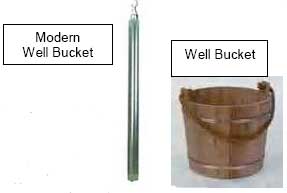
- obtain a "well bucket". An example of this is at Lehman's (search for 'well bucket').
- obtain a short (about two feet) section of threaded galvanized pipe that will fit in the well casing. Cap the bottom. Drill a small hole in the top and tie a rope to it. Lower the pipe into the well, and pull up after it fills.
This water will need to be treated before drinking, because the well will have contamination from being opened and the pump removed.
Alternative Water Sources
Consider these sources. It would be best to scout out where these sources may be now and to consider how water can be transported if fuel is scarce or prohibitively expensive.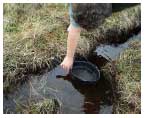
- Rainwater
- Streams and rivers
- Ponds and lakes
- Natural springs
These will likely have contamination; regardless of how "clear" the water looks. Be sure to:
- Filter this water. This is to remove Giardia and Cryptosporidium
- Treat this water by boiling or chemical disinfection. See "Emergency Purification" for detailed instructions.
Filtering Water
The "Gilmore" 2-bucket System. This system is very simple and can be made in 10 minutes. It is easy to store and requires no mechanical skill. Except for the filter, all materials can be found locally, and the buckets are often free from bakeries. This is an excellent project for someone new to preparing.
- The following is a home-made water filtering system courtesy of "Gilmore." This filtering system will remove microorganisms EXCEPT viruses. USE CHLORINE (OR BOILING) TO GET RID OF ANY VIRUS THAT MAY BE IN YOUR WATER! Filter your water using this system first, THEN use the chlorine (or boiling) for purification.
- Materials needed: Two (2) five gallon FOOD GRADE buckets, a Berkey Big Black water filter, and optional spout.
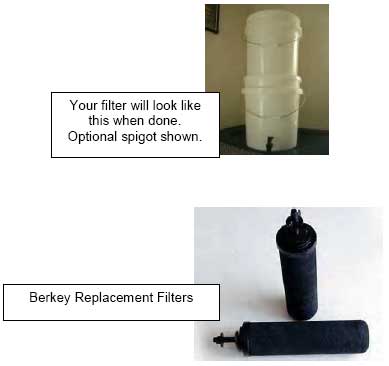
- To find Berkley filters, search the internet for "Berkey replacement filters." The filters can be cleaned with Scotch-Brite cleaning pads. Each filter will process about 3000 gallons. Strain water beforehand if there is visible debris or if using pond or puddle water.
Assembly Instructions: One lidded bucket will be placed on top the other lidded bucket. The top bucket will hold the unprocessed water, and the bottom bucket will catch the water that has been filtered.
- Find a drill bit just slightly larger than the stem on the filter. Set the bottom of one bucket on one of the lids. Mark the center of the bucket bottom. Drill a hole through the bottom of the bucket and the lid that it is on. These holes allow the stem of the filter to pass through the buckets, but will keep the body of the filter from slipping through.
- Remove the nut from the Berkey replacement filter stem.
- Place the bucket with the hole in the bottom on the lid with the hole. Push the stem through these holes, and screw the nut (finger tight) onto the stem.
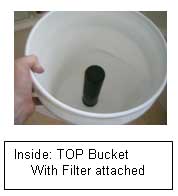
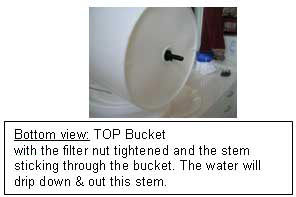
- Gently place the bucket and lid with the filter ONTO the top of the second bucket.
- Fill the upper bucket with water, and place the second lid on the top bucket. Gravity will feed the water through the filter.
- Remember – the filtered water will still need to be chemically treated or boiled to kill viruses.
Last resort filtering
If you have no commercial filtering system, consider a slow sand filter, Go to the ‘Water Treatment FAQ’ in the downloads section of this website. A description and construction details are in the 'Slow Sand Filter' section.